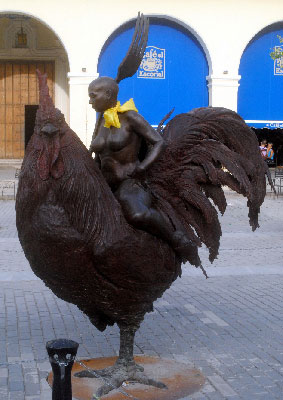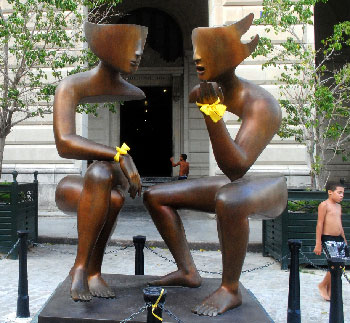Cuba’s Pending Campaign
Irina Echarry
 HAVANA TIMES — Much is being said about Cuba’s recent yellow-ribbon campaign. What was most striking about the whole process, for me, was seeing how easily people buy into a given product or message. Of course, everything depends on how such a product is advertised.
HAVANA TIMES — Much is being said about Cuba’s recent yellow-ribbon campaign. What was most striking about the whole process, for me, was seeing how easily people buy into a given product or message. Of course, everything depends on how such a product is advertised.
This campaign was based on a love story. Many years of watching cheesy soap operas have made us receptive – or more receptive than we were to begin with – to such mushy and tired ideas as eternal love, fidelity in marriage, the mother who never betrays her children and other clichés.
From the start, it was clear that involving many people in the campaign wouldn’t be difficult. First, you identify a given value (fidelity) and associate it with a specific color (yellow). Then, you tell a pretty and moving story and tell people what they have to do. After that, you start hanging up yellow ribbons around the city…confident the fire will spread.
On the morning of September 12, the streets were flooded by a yellow tide: yellow blouses, undershirts, ribbons, earrings, t-shirts, bands hanging from balconies, tied to windshield wipers and tacked to the doors of houses.
Many of us asked ourselves if people were simply going through the motions (as in most campaigns in Cuba) or if they were genuinely demanding justice for the Cubans imprisoned in the United States. After listening to the “masses”, I have to conclude that, whatever their motives, most people were actually, emotionally involved in the campaign.
Some people even showed a bit of creativity. Not everyone used the yellow ribbons the State sold. A number of people were more discrete and latched yellow origami figures to their key chains. Others simply opted to wear a yellow collar.
On the bus, I heard a group of young people talking about the consequences of the lack of freedom, “about those poor guys, dude, who’re in the slammer.”
The phoniest spectacle I saw involved a group of children who, standing in a square in Alamar, shouted “freedom!” repeatedly, while their teacher asked them to be quiet and warned them that they would go on rehearsing until everyone yelled the words as loud as they could. This and, of course, the spots we were bombarded with for days through Cuban television.
I am actually surprised at the enthusiasm people showed. Recently, we had a campaign against gender-related violence. Violet was the color chosen for the campaign (I’ve been told this is feminism’s representative color). Very few people joined the campaign, however.
 The campaign poster girl was Cuban singer Rochy. While it is true that she is not that popular, one would think that, in a country with so much political apathy, young people would be more prone to follow an artist than a political spokesperson such as Rene (the one member of the Cuban Five who has served his prison term and been released).
The campaign poster girl was Cuban singer Rochy. While it is true that she is not that popular, one would think that, in a country with so much political apathy, young people would be more prone to follow an artist than a political spokesperson such as Rene (the one member of the Cuban Five who has served his prison term and been released).
Rochy and her gang took a message of peace and equality among men and women to all of the country’s provinces, but did not manage to involve that many people in the campaign.
Some time before, singer-songwriter Haila (who is much more popular) headed a campaign sponsored by the UN Secretary General, also calling for an end to violence against women and little girls.
Haila, known as the “People’s Diva”, appeared in a poster showing a hand with a single nail painted violet. This, however, did not catch on among young people on the island.
I am surprised because the campaign calling for the release of the Five (who are now actually four) revolves around an isolated case which involves only the imprisoned agents and their families, while gender-related violence is a wide-encompassing phenomenon which affects the majority of Cuban families.
I am not suggesting that a campaign impose a certain color on a given issue. It’s clear to me that wearing this or that color doesn’t actually change anything.
What the yellow-ribbon campaign has shown me is that the Party-State is clever when it wants to be, and could well impel (or support) a good campaign against domestic violence, using different mechanisms and plenty of originality, appealing to mushy clichés or not, and raising people’s awareness in this connection, to the point of formulating a specific law related to this issue. My question, therefore, is: what’s it waiting for?

Cubans did not “embrace” this campaign. As the blogger points out, the dictatorship staged a nationwide effort to present a false face of unity. Few were fooled. Well, maybe you. Anyway, the “capitalist press” works according to a ‘herd’ mentality. Everybody in the mainstream media reports the same ‘big’ news stories. That week we read about a possible military invasion of Syria, deadly floods in several parts of the US, and various mayhem around the globe. A yellow ribbon campaign in a small poor communist country just didn’t make the cut. So no, it would not seem newsworthy to me and millions of other Americans when compared to the other events taking place in the world that week. No one “manages” the press as is done in Cuba. The international press simply chose to ignore the story because it would not sell advertising space. The fact is, and this may be painful to you, most people in the US could not care less what happens in Cuba.
Let me get this straight. An entire country embraces a yellow ribbon campaign to free five individuals they claim to be political prisoners held by the United States. That is they hijacked an American symbol to protest against something America “doesn’t do ” , imprison for political reasons. Would seem sort of newsworthy, wouldn’t it.? And yet Moses triumphantly says it did not appear anywhere in the US media. I had to laugh. Here is the guy, constantly spouting off about the lack of freedom of the press on the island. Yet when confronted with an example about how the capitalist press achieves its goal to misdirect and manage public opinion, he can’t see it standing right before him.
How do you define success? A totalitarian regime succeeds in coercing a lot of people into tying pieces of yellow fabric to various objects. The act itself signifying bother the impotence and the malevelance of the regime.
That’s not a success. It’s yet another failure to do anything meaningful and helpful for the Cuban people.
Again the regime has shown how callous and hypocrite it is: forcing children to shout “freedom” while denying them real freedom.
Despite the success of the yellow ribbon campaign in Cuba, the intended message failed to be delivered to the purported audience, the US. No TV coverage whatsoever and with the exception of the Huffington Post, no print media coverage either outside of Miami. Of course, this comes as no surprise to the Castros. The real goal of the dictatorship has never been to actually free the remaining four spies. The goal is continue to maintain a ‘pissin’ post around which to unify the island.